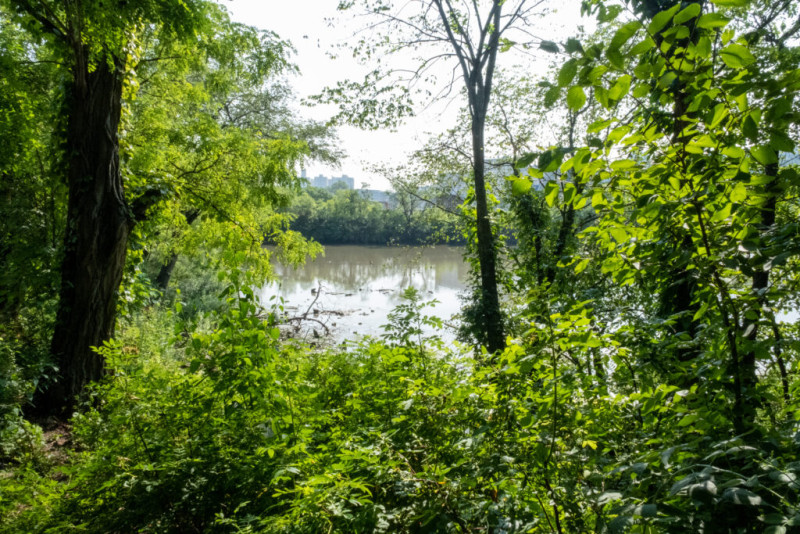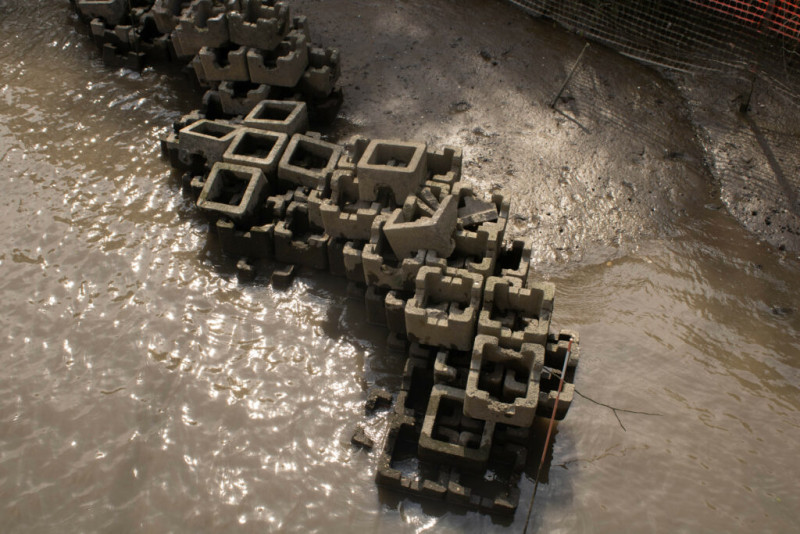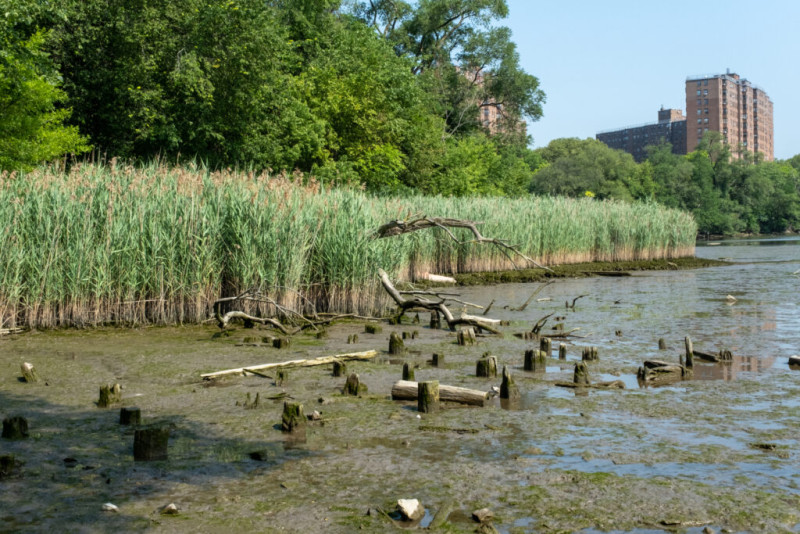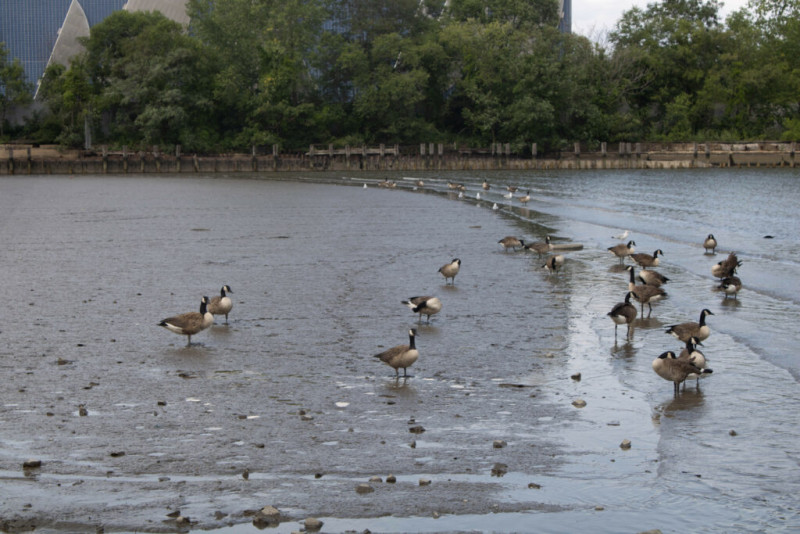This Northern Manhattan Wetland Has Faced Climate-Change-Induced Erosion and Sea Level Rise. A Living Shoreline Has Reimagined the Space
When the New York Restoration Project first started working in the late 1990s to clean the unnamed shoreline along the Harlem River in northern Manhattan, the intertidal mudflat and wetlands weren’t just a neglected area, but a former illegal dumping ground.
How the cove, the largest wetland left in Manhattan, has become a bountiful greenspace where migrating birds, crabs, tadpoles and toads are all thriving, despite the existential threat posed by climate change in shoreline communities, is a story of robust community involvement and skillful coastline management by the New York Restoration Project (NYRP), the parks nonprofit created 28 years ago by Bette Midler, the singer, actress and activist.
“Even though it’s got this terrible legacy of fossil fuel emissions and pollution and neglect,” said Jason Smith, referring to an old Con Edison coal-burning power plant across the river, “it’s still got wonderful environmental benefits. And so we want to be really thoughtful about how to work in the space.” Smith is the NYRP’s director of northern parks.

Within the 520 miles of vulnerable coastline in New York City, Swindler Cove is one of several “living shoreline” projects in which natural infrastructure efforts have been employed to help stop storm erosion and cope with climate-induced sea level rise.
In March, the nonprofit Save the Sound announced it had received $750,000 from New York’s Water Quality Improvement Program for the Big Rock Wetland Restoration Project in Queens. The organization plans to install “oyster castles,” much like those in place at Swindler Cove, to restore four acres of salt marsh.
In Jamaica Bay, near Kennedy Airport, a project led by the Jamaica Bay-Rockaway Parks Conservancy has restored wetland habitats that were breached by Superstorm Sandy. The conservancy formulated an experimental living shoreline that consisted of planting marsh grasses to help secure new sand fill.
And on Long Island Sound, a series of Living Shoreline Projects are restoring acres of wetland habitats that had fallen victim to rapid beach erosion. The solutions in these projects range from site to site, all specific to the needs of the environment and focused on improving resilience to sea level rise.
Swindler Cove is part of Sherman Creek Park, which surrounds Public School 5, the Ellen Lurie elementary school, and the New York City Housing Authority’s Dyckman Senior Center. “This is one of the most vulnerable neighborhoods in northern Manhattan,” Smith said, as he pointed to the Dyckman Apartments and P.S. 5. “It’s another reason why when we’re talking about resilience and restoration work here, we really want to make sure we have a broader conversation with the school … Because if you look at the flood maps for 2050 from New York City, this is all in the floodplain, it will be one of the first areas impacted by sea level.”
Many New York Public Housing buildings are located in flood zones. “I think the reality for most of the nation, the cheap and inexpensive plan to develop and build on included a lot of your flood hazard areas,” said Chad Berginnis, executive director of the Association of Floodplain Managers, a national scientific and education organization that represents state and local officials on floodplain management issues.
Experts in floodplain management now recognize that special attention must be paid to public housing built in the floodplain, Berginnis said. “It seems just flat out wrong” that those who can least withstand a disaster live “in the highest hazard areas.”
Protecting the Shoreline
Over the years, Smith and his team have worked at Swindler Cover to slow down the effects of climate change-induced erosion on the shoreline. According to the New York City risk landscape study, “erosion occurs at a much faster rate during coastal storms, when large sections of beaches, dunes, and bluffs may be lost in a matter of days or even hours.”
In his first years at Swindler Cove, Smith noticed about 30 feet of shoreline erosion there. “When we first started seeing the wetlands washing away, no one really knew why. And it took a while to even establish a consensus that yes, sea level rise was one of the driving forces in the park starting to erode,” he said. “This is the largest wetland left in Manhattan.”
“There are different types of erosion,” said Kerryanne Donohue, a Manhattan College civil and environmental engineering instructor. She explained that Sherman Creek most likely experiences both coastal erosion from sea level rise and fluvial erosion from rainfall. “Erosion due to high-intensity rainfall events seems to be happening more and more, we were learning,” she said.
Smith and his team are using a variety of different approaches to maintain the shoreline. In 2020, to mitigate erosion, NYRP volunteers built oyster castles, artificial reefs made of concrete structures stacked on top of each other, to create the “living shoreline.”

The reef helps break waves to allow sediment more time to deposit through a process called wave attenuation. The castles create a marine habitat for the oysters (and a snack for the neighborhood critters) as they allow water to pass through them and slow down sediment.
Edwards Santos, Sherman Creek park manager at the New York Restoration Project, noted the impact of young Spartina, a common grass found in coastal salt marshes, growing at Swindler Cove. The grass provides many resiliency benefits to the environment, soaks up stormwater, reduces soil erosion with its root system and stores carbon. “Having more native species to defend the city and any possible land we get back is best,” Santos said.
Santos has worked at Swindler Cove since 1996, when Billy Swindler, the namesake of the cove, took an interest in expanding the services NYRP offered at Sherman Creek Park. Swindler, a city garden advocate, was already working with students from P.S. 5 to plant in the “as-yet-unborn park.”
“The wetland area is now thriving,” Santos said. “You have nice tall Spartina grass setting in and it has already started spreading. Hopefully next year, it will even expand a little bit more.”
The non-native phragmites, a common reed, also contribute in multiple ways to the resiliency of the park and neighborhood. Smith explained that the reed helps pull carbon out of the habitat and decreases nitrogen in the water. According to the Environmental Protection Agency, excess nitrogen in cities commonly comes from wastewater removal.

“Nutrients are commonly considered to be very beneficial for plant growth,” said Jessica Wilson, an associate professor of civil and environmental engineering at Manhattan College. “The issue comes in when you have an excess of nitrogen and phosphorus because they contribute to what’s called eutrophication, which is excessive algal growth. You can essentially have too much of a good thing when you’re dealing with excess nutrients coming into any water body.”
Wilson said the phragmites take nitrogen and phosphorus from the water for their own growth, and also from the sand, silt or clay they are growing in.
The city’s antiquated combined sewer overflow system discharges raw sewage replete with nitrogen and phosphorus directly into estuaries like Swindler Cover when it gets inundated with water from increasing storms that are becoming more intense due to climate change. “In some ways, New York City’s biggest environmental impact is the sewage we dump, which we don’t like to think about that much,” Smith said.
NYRP: Moving at “the Speed of Trust”
NYRP considers Sherman Creek Park and Swindler Cove a “crown jewel” of its ongoing work in the city’s parks.
“It always comes back to the communities that we serve. Part of our ethos, and how we think is, nobody is an expert on their community except for those people that live in it,” said Lynn Bodnar Kelly, executive director of New York Restoration Project. “We have experts in horticulture, agriculture, tree care, you name it, but we have to listen to community members to understand what is it that they envision.”
She said the NYRP’s longtime relationship with Inwood, a neighborhood on the northern tip of Manhattan, has contributed to much of its success in restoring Swindler Cove. “To get anything done in New York, you have to move at the speed of trust. You can’t just come into a neighborhood that doesn’t know you and expect that everything is going to come together seamlessly,” said Kelly.
Smith sees working with the community and various partners as essential to the restoration and day-to-day stewardship of the park. “We’ve also brought on a team with a social scientist and an ecologist who specialized in talking to people about science. They’ve developed a kind of site-specific methodology they call sidewalk science,” he said. “Because this is going to be a generational shift in how we relate to the water in New York. We’re really feeling our way into what that conversation should look like in this neighborhood.”
For Smith’s operations, community engagement encompasses all of the different types of people who interact with Sherman Creek Park. NYRP works with students in New York City as well as the residents in the neighborhood. According to Smith, each community member can create and engage because there are different ways to work.
Volunteers can get involved with Sherman Creek through shoreline litter removal, invasive vegetation management or working in Riley-Levin Children’s Garden.
Berginnis echoed a similar philosophy toward floodplain management. “Holistic floodplain management is really thinking about what the community’s goals and desires are, making sure that we’re steering development in an appropriate way,” he said.
All of the restoration work in metropolitan greenspaces, he said, underscores “the natural value in functional floodplains. In many of our urban areas, for example, we have populations that don’t have good access to green space, parks, and all of the good health and community benefits that those provide.”
Ben Sadock, a resident of Inwood for thirteen years, enjoys observing the variety of migratory freshwater birds that appear at Swindler Cove. “I spend some time in the Swindler Cove section where there’s some restored salt marsh,” he said. “I just look around and listen because you know, it’s easier to hear a bird than see one.”

“I think it’s good for people who live in the city to be around biodiversity. And to understand that human habitats and wildlife habitats aren’t necessarily in conflict,” said Sadock. “The gardens in Swindler Cove are very beautiful and you don’t need to be a nature enthusiast to enjoy them. It’s a peaceful spot right on the water and being next to the water in Manhattan is a special thing. There aren’t that many places you can do that.”
A Work in Progress
Now, three years into the restoration of Swindler Cove’s shoreline, with the impacts of climate change accelerating, Smith said the plan going forward must embrace constant change. “In traditional restoration, the real gold standard is to do something and then go home, and it takes care of itself,” he said. “In New York City, and in an era of rapid global change, people are realizing that that model doesn’t work. And so we’re really fortunate, we have a staff here every day, our park crew, and so we can look at what’s happening and modify it as needed.”
As he walked through the cove, remnants of its blighted and polluted past still surface. He pointed to an engine block of an old boat partially hidden in the mud. “We’re renewing and expanding different conversations with the community,” he said of the need to build a new relationship with nature.
Smith expects his team will have to continually modify their restoration efforts as conditions change. “We can see what’s working and what’s not working, until it’s good, because it keeps things interesting,” he said. “I think it’s very important to remember, yes, we’ve got big problems, but there’s also in some cases, very elegant solutions that are not so hard to do.”
Disclaimer: The copyright of this article belongs to the original author. Reposting this article is solely for the purpose of information dissemination and does not constitute any investment advice. If there is any infringement, please contact us immediately. We will make corrections or deletions as necessary. Thank you.







